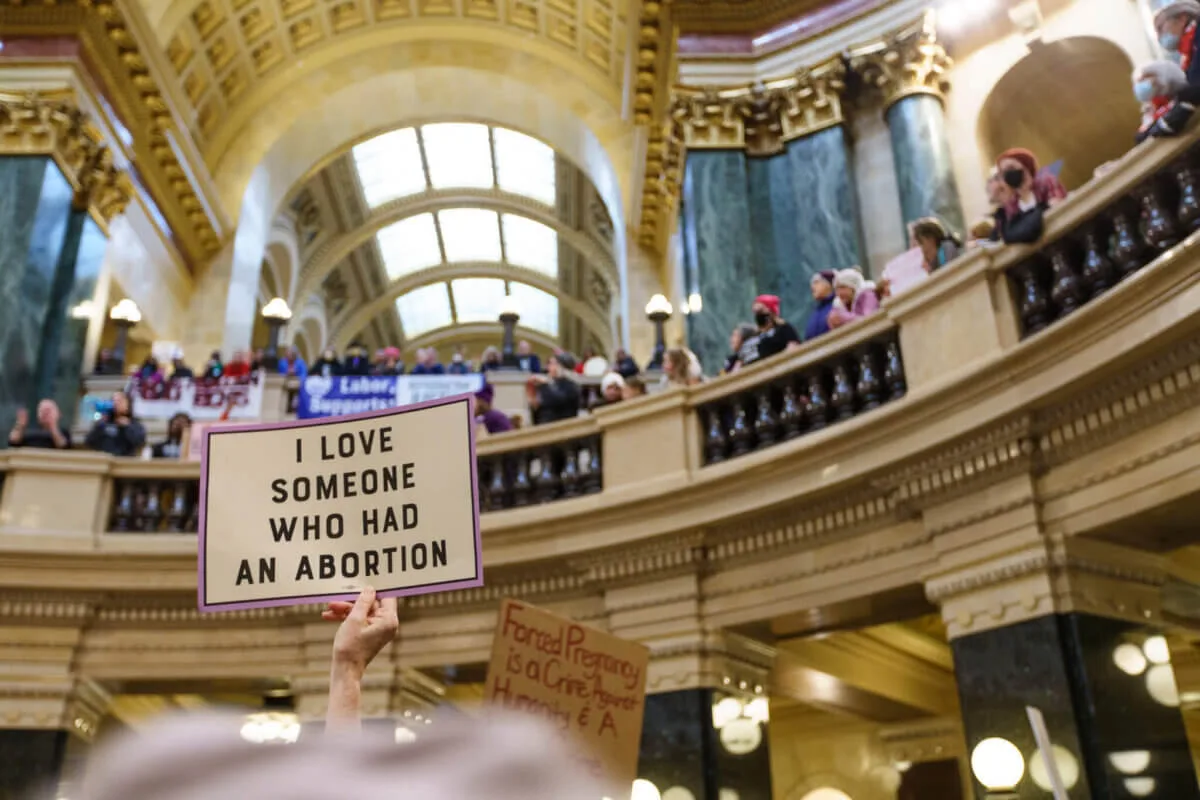
Abortion rights supporters rally at the Bigger Than Roe National Mobilization March in the rotunda of the Capital in Madison, on January 22, 2022. (Photo by Sara Stathas for The Washington Post via Getty Images)
Should Wisconsin women have their reproductive freedom dictated by a law that was passed 174 years ago, when life was completely unrecognizable to those of us living today? Voters may decide the answer to that question on April 4, when they vote in Wisconsin’s Supreme Court election.
Can you imagine a world where up to one-third of children die before the age of five, where drinking milk could easily kill you, and where cars, phones, and televisions don’t exist?
That’s what life was like in the United States in 1849, when Wisconsin’s legislature passed an abortion ban that makes no exceptions for cases of rape or incest. The law only allows abortions when necessary to save the mother’s life—and even then, only when it “is advised by 2 other physicians as necessary, to save the life of the mother.”
Under the law, any doctor who performs any other kind of abortion in violation of the law can be charged with a felony and face up to six years in prison and $10,000 in fines.
One hundred and seventy four years, a Civil War, and two World Wars later, millions of Wisconsin women are currently living without reproductive freedom because of this abortion ban. The law, which had been dormant for decades, once again became active following the US Supreme Court’s decision to overturn Roe v. Wade last summer, returning abortion regulations to individual states.
The 1849 law could soon be overturned, however, depending on the outcome of Wisconsin’s April 4 state Supreme Court election. A lawsuit challenging the ban is likely to reach the state Supreme Court, which is currently made up of a 4-3 Republican majority.
If pro-choice candidate Janet Protasiewicz wins, the 1849 law could be struck down, once again legalizing abortion in Wisconsin.
If anti-abortion judge Dan Kelly wins on April 4, it would likely mean that women in Wisconsin would continue to have their reproductive freedom controlled and restricted by a law that was passed before they had the right to vote—and before there was even a woman lawyer in the US who could challenge the ban.
Here are some other facts about what life was like in 1849, when the ban was passed:
- Slavery was legal in many states
- The average life expectancy in the United States was under 40 years old
- Roughly 22% of white children and 34% of Black children died before the age of five
- We didn’t know germs caused disease
- Infectious diseases like cholera, typhoid fever, typhus, and diphtheria were the leading causes of death
- Diarrhea was identified as a leading cause of death
- Millions of people died from drinking milk, because pasteurization had not been invented and diseases spread through raw milk
- Vaccines hadn’t been invented
- There were only 30 states in the United States
- Wisconsin’s population was roughly 300,000 people, compared to nearly 6 million today
- Child labor was the norm, and in some cases, children as young as 5 were expected to work
- Cars didn’t exist
- Traffic lights didn’t exist
- Movies didn’t exist
- Radios didn’t exist
- Sewer systems didn’t exist
- Washing machines didn’t exist
- Toilet paper didn’t exist
Should women in Wisconsin have their reproductive freedom dictated by a law that was passed 174 years ago, when life in the US was almost completely unrecognizable to those of us living today?
Voters in the state may well decide the answer to that question on April 4.
Politics

Eric Hovde’s company exposed workers to dangerous chemicals, OSHA reports say
A Madison-based real estate company run by Wisconsin US Senate candidate Eric Hovde settled with the Occupational Safety and Health Administration...

Plugged in: How one Wisconsin school bus driver likes his new electric bus
Electric school buses are gradually being rolled out across the state. They’re still big and yellow, but they’re not loud and don’t smell like...
Local News

Stop and smell these native Wisconsin flowers this Earth Day
Spring has sprung — and here in Wisconsin, the signs are everywhere! From warmer weather and longer days to birds returning to your backyard trees....

Your guide to the 2024 Blue Ox Music Festival in Eau Claire
Eau Claire and art go hand in hand. The city is home to a multitude of sculptures, murals, and music events — including several annual showcases,...



